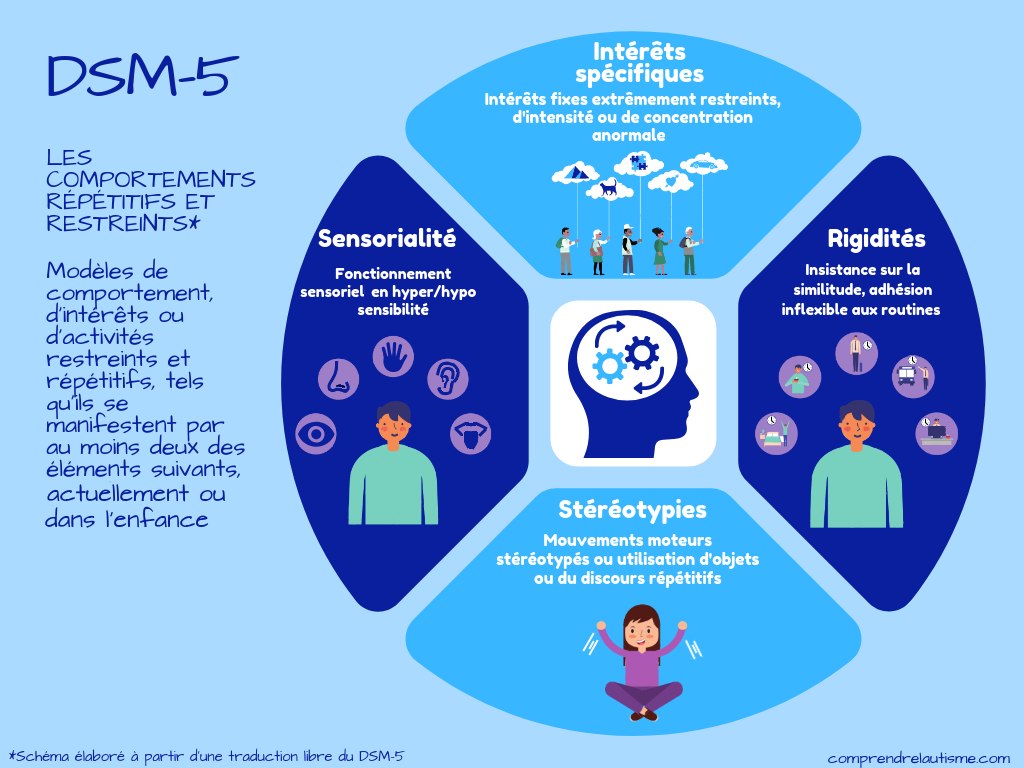How do you prevent or manage certain behaviours?
Here are ten tips on managing the behaviours of the autistic person you are caring for.

The topic of behaviours is key when it comes to autism spectrum disorder:
Limited, repetitive or stereotyped behaviours are self-regulatory strategies used by the individual, especially when the environment seems stressful, ever-changing or unpredictable.
The behavioural manifestations of individuals with autism affect their ability to receive adequate medical and psychiatric care throughout their lives, as do difficulties with communication.
The limited, repetitive and stereotyped nature of the activities, interests and behaviours is illustrated in this diagram from the Comprendre l’autisme [Understanding Autism, (in French only)] website, in its infographics on autism section (in French only).

The limited behaviours, activities and interests of the person you are caring for impact their quality of life, as well as yours and those around you. You may feel the need to employ a few tips and tricks:
From a medical standpoint, it is important to try to understand the causes and purposes of these behaviours through an assessment:
What might be some avenues of resolution for certain behaviours?
The profile of individuals with an autism spectrum disorder can vary greatly depending on the associated conditions, level of functioning, environment in which it occurs, age of onset of the types of manifestations, degree of severity, and degree of stimulation provided. Together with the person you are caring for, you can develop your own tips for managing behaviours.
From management to insertion
We suggest that you watch the documentary La belle différence (in French only), available in its entirety on Unis.tv; the film talks about differences, yes, but above all about authenticity, and this is a great help when you are worried about employment, activities and independent living for your child.
But what about my own behaviour?
As a caregiver, the help and support you provide to the person you care for is a mutual exchange and learning process. If the person you care for (or your child) is learning to manage their behaviour, so are you: you are learning from and with the care receiver. You can also broaden your knowledge and experience and get in touch with resources and services tailored to your needs.
Practical tools
Guides
Activities
A pour Autre. La plateforme web interactive qui s'adresse d'abord aux jeunes avec un trouble du spectre de l'autisme (TSA), à compléter pour les proches aidants avec le guide associé
Books
Alexandre Poirier-Charlebois. Ma vie avec l'Asperger
Brigitte Harrisson, Lise St-Charles. L'Autisme expliqué aux non-autistes
Brigitte Harrisson, Lise St-Charles. L'estime de soi et l'autiste
Sensitization, information and mediation material developed by the Fédération québécoise de l’autisme (Québec autism federation)
Parenting
Catherine Kozminski et Nathalie Poirier. Autisme et adolescence
Observations et réflexions pour soutenir la fratrie des personnes TSA. Guide aux parents
Nathalie Poirier et Jacinthe Vallée-Ouimet. Le parcours des parents et des enfants présentant un TSA
It is a disease, not a condition. The nuance is important!
Comedian Louis T may be a comedian, but his vocabulary lesson may not always make you laugh.
Understanding the way autism spectrum disorder is named and the words that are used to describe it is already a step towards a better mutual understanding and social inclusion of autistic people. We all have a long way to go in this respect.
Agence de la santé et des services sociaux de la Montérégie. TSA et neurotypique. Mieux se comprendre - Guide pour comprendre le fonctionnement de la personne ayant un trouble du spectre de l’autisme.
Chaîne Youtube de Bibliothèque et Archives nationales du Québec. La leçon de vocabulaire avec Louis T.
CHU Sainte Justine Centre hospitalier universitaire mère-enfant. Troubles du spectre de l'autisme TSA.
Institut universitaire en déficience intellectuelle et en trouble du spectre de l’autisme. Au-delà du TSA : des compétences parentales à ma portée.
Institut universitaire en déficience intellectuelle et en trouble du spectre de l’autisme. Au-delà du TED : des compétences parentales à ma portée.
Need to talk?
Contact our Caregiver Support Helpline for counselling, information and referrals.
Every day from 8 a.m. to 8 p.m.
Free of charge.